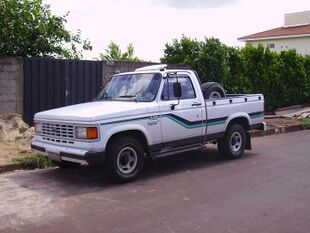Engineering:Chevrolet D-20
| Chevrolet D-20 | |
|---|---|
 | |
| Overview | |
| Manufacturer | Chevrolet (General Motors) |
| Production | 1985 - 1996 (pickups), 1989 - 1994 (SUVs) |
| Assembly | Brazil Argentina |
| Body and chassis | |
| Class | Pickup |
| Layout | Front engine, rear-wheel drive |
| Related | Chevrolet Bonanza Chevrolet Veraneio |
| Powertrain | |
| Engine | D-20
Perkins Q20B4, Maxion S4/S4T/S4T-Plus A-20 and C-20 4.1 L, 6 cylinder (based in 250-S) |
| Transmission | 4/5-speed manual |
| Dimensions | |
| Length |
|
| Width | 2,000 mm (78.7 in) |
| Height | 1,880 mm (74.0 in) |
| |uk|Kerb|Curb}} weight | 2,040–2,290 kg (4,497–5,049 lb) |
| Chronology | |
| Predecessor | Chevrolet C/K |
| Successor | Chevrolet S10 |
The Chevrolet D-20 (or 20 Series) is a series of pickup trucks manufactured by Chevrolet in Brazil and Argentina as a replacement for the 10 Series. When it was first launched, it could be ordered with a 4.1 liter gasoline or ethanol engine (C-20 or A20, respectively) or a 3.9 liter Perkins diesel (D-20). In 1991, the Perkins was replaced with the Maxion S4 4.0L diesel making 90 PS (89 hp) and the turbocharged Maxion S4T making 125 PS (123 hp). In 1995, the S4T was readjusted to match the Euro-II emission limits, producing 150 PS (150 hp). This version was called Turbo Plus, and equipped with mechanical ABS in the rear. Whilst all models are commonly referred to as D-20, the gasoline model was marketed as the C-20, and an otherwise mechanically identical ethanol-fueled version as the A-20.
As well as single-cab and crew-cab versions, Chevrolet sold mechanically identical SUVs, called Bonanza (similar to the Blazer or 2-door Tahoe) and Veraneio (similar to the Suburban).

This article does not cite any external source. HandWiki requires at least one external source. See citing external sources. (2021) (Learn how and when to remove this template message) |
 |


